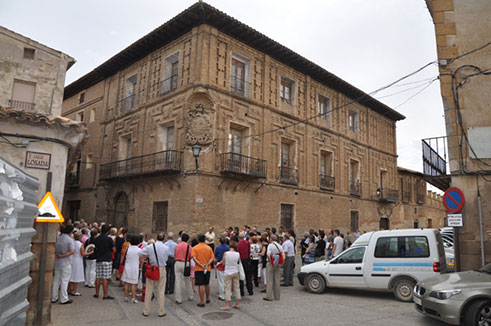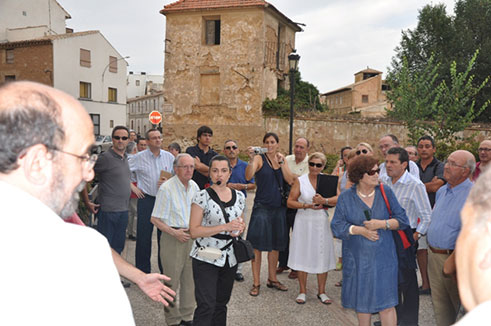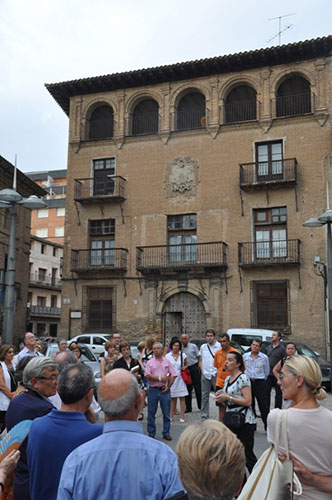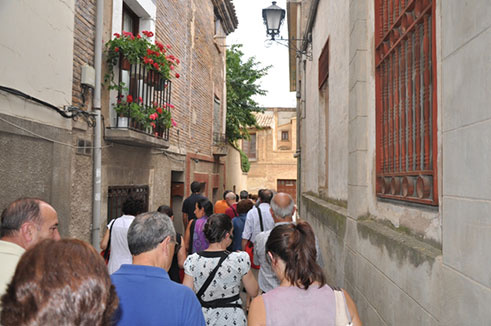BRINGING HERITAGE CLOSER. CORELLA
26 August 2010
Corella, conventual and palatial city: visit guided tour
Ms. Pilar Andueza Unanua. Chair of Navarrese Heritage and Art
The 17th and 18th centuries were decisive for the urban and monumental configuration of the town of Corella, as they gave it an indisputably Baroque imprint through its most significant urban spaces and its most outstanding buildings, giving rise to a conventual and palatial town, largely sponsored by the town's elites.
The intense foundational work of the religious orders during the Catholic Reformation led to the construction of numerous convents and monasteries, a phenomenon that spread throughout the country. The deep religious convictions also led parish councils, town councils, brotherhoods, confraternities and private individuals to build, extend or reform chapels, chapels, hermitages, basilicas and parishes in parallel, giving rise to what Cervera Vera coined as the conventual city. Corella clearly responds to this concept, as during those centuries three convents were built (male and female Discalced Carmelites and Mercedarians) and a monastery (Benedictine), the basilica of Nuestra Señora del Villar, several hermitages and chapels at board of trustees, without forgetting the great works undertaken in its parish churches.
At the same time, Navarre had its own customs legislation. This privilege, together with its strategic geographical position, located next to the border with Castile and in the middle of two fundamental routes of speech such as the royal road that ran from France to the Town and Court and the Ebro route that ran from the Basque Country towards the Mediterranean, were essential for a large number of traders and businessmen to emerge in the city. group . They based their juicy income on the import of Castilian wool, which they took to France and from there put luxury goods and spices on the market Spanish . Having achieved material success, they soon wanted to accompany it with a parallel social recognition that took the form of their accession to the nobility. But it was not only necessary to be a nobleman. You had to live like one. Consequently, they built magnificent family residences as a symbol of the power they had attained, and they also engaged in intense luxury consumption to lavishly furnish their interiors. A palatial city was born, where the new buildings, always made of brick, were characterised not only by their location in the urban fabric, but also by their baroque style. Among the most notable houses are those of the Sesma family, known as the house of the Cadenas, which housed the royal family in 1711, and several properties belonging to the Miñano Sesma, Sopranis, San Juan and Goñi families, to name but a few examples.

The group course attendees listen to the explanations given by the teacher Pilar Andueza Unanua in front of the Sesma family house in Corella.

Different moments of the visit guided tour of the city by Professor Pilar Andueza.

A moment during the tour of the city in front of the Virto's house.

PROGRAM
Tuesday, 24th August
Milestones in the History of Corella
D. Esteban Orta Rubio. Society of Historical Studies of Navarre
Writers and publicists of Baroque Corella
Mr. Javier Itúrbide Díaz. Uned of Tudela
Corella in the culture and art of the Baroque period
D. Ricardo Fernández Gracia. Chair of Heritage and Art of Navarre
Wednesday, 25th August
The hidden Corella. Behind the lattices of the city's enclosures
D. Ricardo Fernández Gracia. Chair of Navarrese Heritage and Art
The sumptuary arts: at the service of the splendour of worship and the Liturgy
D. Ignacio Miguéliz Valcarlos. Chair of Navarrese Heritage and Art
The festive calendar
D. Francisco J. Alfaro Pérez. University of Zaragoza
visit to the church of San Miguel
visit to the tunnels
Thursday, 26th August
A look at architecture and the arts in Corella in the 19th and 20th centuries
José Javier Azanza López. Chair of Navarrese Heritage and Art
The image of the Rosary and Saint Michael in the arts
Ms. Mª Gabriela Torres Olleta. GRISO. University of Navarra
Corella, conventual and palatial city: visit guided tour
Ms. Pilar Andueza Unanua. Chair of Navarrese Heritage and Art
Closing

